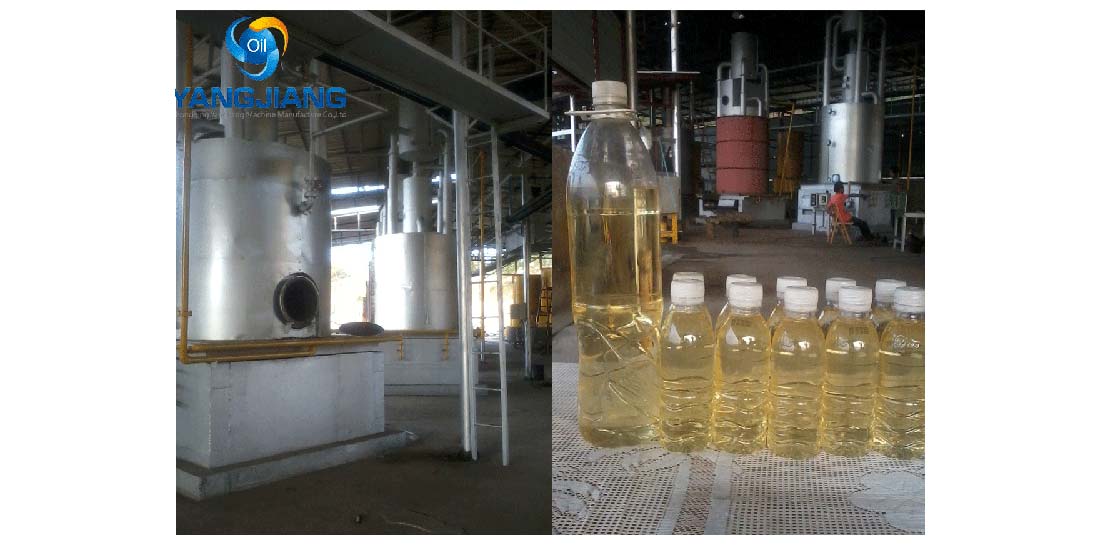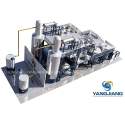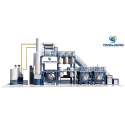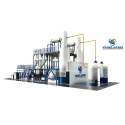Fully Automatical Waste Oil Refinery Plant and Used Oil Regeneration Machine
The waste oil refinery plant can re-refining gasoline motor oil, diesel motor oil, all kinds of engine oil, mineral oil, synthetic oil and other waste lubricant oil, transmission oil, hydraulic oil, gear oil and other used black lubricant oil to clean diesel oil with a high regenerate rate more than 85%-90% and low cost. What's more, it has practically negligible pollutants for the environment.
1. Why We Re-refine Used Motor Oil to Diesel Fuel?
The oil lasts for thousands of years. Once it is refined and used in our vehicles only to be discarded 3,000 miles later, it is still in a form that will keep for many years. Motor oil mainly used in auto engines, transmissions, gear-boxes, turbine transmission devices, etc. No matter what sizes of cars or vessels, the period and standard of replacement are explicitly stipulated(once a month). Calculating based on a medium or small scale city, all sorts of cars, farm vehicle, mechanic cars generate spent oil approx 1000T. Add to the leftovers from refineries, chemical plants, fertilizer plants, coking plants, etc. The total quantity is stupendous huge. Disposal through burning or dumping is not only brought heavy environmental pollution, but also cause an enormous waste of energy. No matter eyes on energy resource reuse or environmental protection, bringing huge economic benefits to producers, waste oil regeneration has a very good prospect.

2. Feasibility of Used Motor Oil Cracking:
- There are two ways to manage the spent lube oil, the first is to recycle it into lube base oil, and another method is to crack it into fuel. The same technology however that distills motor oil from crude oil is essentially the same technology that distills used oil into diesel fuel. The process to re-refine used motor oil is easier than refining crude oil.
- During processing, gasoline and diesel could be obtained through different distillation temperature ranges. 50-160℃ is the gasoline fraction range, and 160-410℃ is the diesel fraction range. After cracking and cooling, about 2-5% of the liquid is gasoline. Approx 85-90% liquid is similar to diesel and able to meet the specification of -15# diesel.
- They’re able to be used as industrial or civil-use fuel, even power-driven fuel. Motor oil is from a fraction after diesel in the oil refining industry, they belong to the same petroleum family having different molecular weight, it is very feasible to produce diesel.
3. How to Crack Used Motor Into Diesel Fuel?
- Oil can be used in many different products, and this is because of its composition of many different hydrocarbons of different sizes, which are individually useful in different ways due to their different properties. The purpose of a refinery is to separate and purify these different components. Most refinery products can be grouped into three classes: Light distillates (liquefied petroleum gas, naphtha, and gasoline), middle distillates (kerosene and diesel), and heavy distillates (fuel oil, lubricating oil, waxes, and tar). While all of these products are familiar to consumers, some of them may have gained fame under their refined forms.
- Cracking is a petroleum refining process in which heavy-molecular weight hydrocarbons are broken up into light hydrocarbon molecules by the application of heat and pressure, with or without the use of catalysts, to derive a variety of fuel products. Cracking is one of the principal ways in which used oil is converted into useful fuels such as motor gasoline, diesel fuel and home heating oil.
- Cracking breaks carbon-carbon bonds to turn heavier hydrocarbons into lighter ones. This can occur thermally (as occurs during the petroleum formation process beneath the earth) or through the action of a catalyst.
| Item | Test standard | result | Standard value |
| Density(15℃) | ASTM D1298 | 0.84kg/l | |
| kinematic viscosity(40℃) | ASTM D445 | 3.36cst | 1.6-5.8cst |
| Flash point(closed cup) | ASTM D93 | 60℃ | ≥55℃ |
| Pour point | ASTM D97 | -19 ℃ | ≤ 0℃ |
| Distillation temperature | |||
| 10% point | ASTM D86 | 204 ℃ | |
| 50%point | 289 ℃ | ≤300℃ | |
| 90% point | 344 ℃ | ≤355℃ | |
| 95% point | 359 ℃ | ≤365℃ | |
| Cetane index | ASTM D976 | 54.42 | ≥45 |
| Water content | ASTM D95 | Trace %vol | ≤Trace%vol |
| Sulfur content | ASTM D1226 | 0.151 %wt | ≤0.2%wt |
- In brief, we distill the waste oil, and then crack the lube oil molecule into small diesel molecule, cool down the diesel gas, collect it, and then we can get the new diesel.
- While during the process, there are more details and technical about how to crack the waste oil to diesel fuel oil, and how we become more mature and professional than others. If you interest, welcome to ask YANGJIANG for more information.



